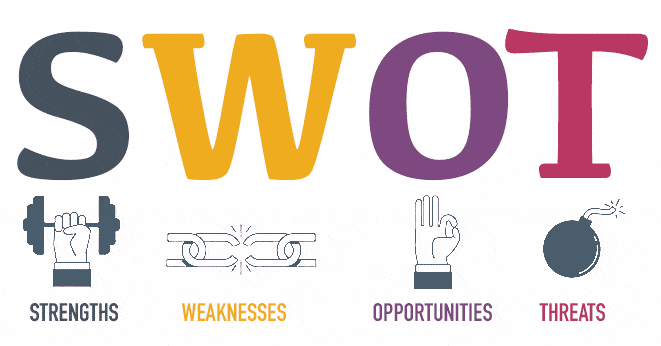Conducting an effective internal communication diagnosis is essential for companies aiming to create a connected, productive, and employee-centered work environment.
In this article, we explore four key steps to assess the state of internal communication (IC), identify strengths and opportunities, and improve connection and engagement within your organization.
The importance of SWOT analysis in an internal communication diagnosis
A SWOT analysis (Strengths, Opportunities, Weaknesses, and Threats) is a fundamental tool for diagnosing internal communication. This methodology captures both quantitative and qualitative metrics, which are crucial for evaluating information flow, employee performance, and job satisfaction.

Using a SWOT analysis for internal communication allows you to:
- Identify Strengths: Detect strong points in communication, such as effective interaction platforms.
- Leverage Opportunities: Find ways to implement new technologies and foster an open communication culture.
- Recognize Weaknesses: Identify communication barriers and dependencies on traditional methods that may hinder interaction.
- Anticipate Threats: Prevent issues like disconnecting with talent or external changes that could impact communication.
Identifying these elements helps anticipate issues and manage changes within the organization for a stronger, more effective internal communication strategy.
Quantifying results for an effective diagnosis
A Deloitte study revealed
that 79% of leaders recognize their responsibility to generate value for their teams, but only 27% of employees feel this is being achieved.
Quantifying SWOT analysis results provides concrete information to assess and adjust strategies, improving the employee experience.
At Oxean, we guide companies in implementing a comprehensive review of internal communication flow on a global scale.

Here, we provide four keys to conducting an effective internal communication diagnosis and actions for a successful evaluation.
Key 1: conduct a SWOT analysis of internal communication
For a SWOT analysis focused on internal communication, it’s important to first define the objective of the analysis. Essential steps include:
Define the objective of the analysis
Clearly specifying the purpose of the SWOT analysis in the context of internal communication is crucial. Objectives may include improving message effectiveness, increasing employee engagement, or enhancing communication channels.
Identify strengths, opportunities, weaknesses, and threats
- Strengths: examples include effective communication channels (intranet, newsletters, messaging platforms) and clear messaging that conveys the company’s mission and goals.
- Opportunities: implementing innovative technologies or promoting an open, two-way communication culture can improve talent satisfaction and retention.
- Weaknesses: obstacles to interdepartmental communication or reliance on outdated methods, like mass emails, may hinder interaction and reduce efficiency.
- Threats: external changes, such as economic crises or competition for talent, can affect the stability of internal communication.
Recognizing these factors enables companies to anticipate problems and manage potential changes within the organization.
Key 2: evaluate internal social networks to improve communication
Internal social networks facilitate fast and collaborative communication within organizations. However, it’s essential to monitor these platforms to ensure they serve their purpose.
The evaluation of internal networks allows you to:
•Observe Interaction: analyze how employees communicate, topics of interest, and the flow of information exchange.
•Optimize Information Flow: use analytics tools to measure effectiveness and adjust strategies based on the results.

This evaluation enables a more accurate diagnosis and enhances the employee experience within the organization.
Key 3: satisfaction and workplace climate surveys in internal communication
Workplace climate surveys are valuable tools for gathering direct feedback on internal communication. They help companies collect data on employees’ perceptions of message clarity and usefulness.
Benefits of workplace climate surveys
- Authentic Feedback: employees can express their opinions and needs.
- Continuous Measurement: regular surveys allow for assessing the impact of IC changes.
- Identifying Improvement Areas: helps the organization identify weak points in internal communication and make informed decisions to improve them.

Implementing surveys enables continuous adjustment of internal communication strategies, optimizing the work environment and increasing engagement.
Key 4: mapping internal stakeholders
Mapping internal stakeholders to improve the internal communication diagnosis is essential. Research by McKinsey & Company shows the importance of segmenting employees based on their “voice” and “influence.”
Stakeholder mapping focuses on:
- Identifying Key Roles: recognizing opinion leaders and strategic areas.
- Understanding Preferred Channels: determining the communication methods best suited to each group.
- Adjusting Content: tailoring messages according to each stakeholder’s profile.
This mapping improves the precision of internal communication, ensuring that messages reach those who need to hear them and strengthening organizational cohesion.

Factors that enhance internal communication diagnosis
In conclusion, an effective internal communication diagnosis should include: SWOT analysis, evaluation of internal social networks, workplace climate surveys, and stakeholder mapping. Together, these elements provide a comprehensive view of strengths and improvement areas in internal communication.

diagnosis of effective internal communication
If you’re looking to strengthen internal communication within your organization, consider implementing these four key actions for a better IC diagnosis.
At Oxean, as a Global Internal Communication Agency, we can provide a complete diagnosis and enhance your team’s performance!
Frequently asked questions
What is an internal communication diagnosis, and why is it important?
An internal communication diagnosis assesses the effectiveness of a company’s communication, helping identify areas for improvement and optimize information flow. It’s essential for creating an engaged and productive work environment.
What are the benefits of implementing a SWOT analysis in internal communication?
SWOT analysis identifies strengths, opportunities, weaknesses, and threats, providing the company with a clear view of areas to improve for a more collaborative and efficient communication environment.
Why are internal social networks important for communication?
Internal social networks enable quick, two-way communication, allowing smooth collaboration among teams. Monitoring them ensures they adapt to organizational needs and enhance communication.
How do workplace climate surveys contribute to an internal communication diagnosis?
Workplace climate surveys provide direct feedback, helping identify improvement areas and adjust internal communication strategies to create a better work environment.
How does stakeholder mapping support internal communication?
Stakeholder mapping allows communication to be tailored according to each collaborator’s role and influence, improving message effectiveness and reinforcing organizational cohesion.




